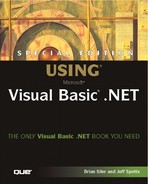Chapter 24. Working with Files
In this chapter
Manipulating the File System Using VB
No matter what development language and platform you use, at some point you will probably need to write code that interacts with underlying operating system files. For example, you might need to copy files or launch another program. You can do all this interactively by using Windows Explorer or a Command Prompt window. As you will see in this chapter, you can accomplish these same file operations easily by using Visual Basic code.
Another use for files is the storage and retrieval of information. In other chapters, you learned how to use databases to store information. However, sometimes the power of a database engine may not be necessary or even appropriate. For example, you may want to create a simple activity log or process a comma-delimited text file. In this chapter, you will examine a couple of options that allow you to store and access information in plain text files with minimal or no structure. We also will look at file streams, which can be used to work with many different types of data. In addition, we will discuss accessing the Windows Registry, where application settings and other information can be stored.
